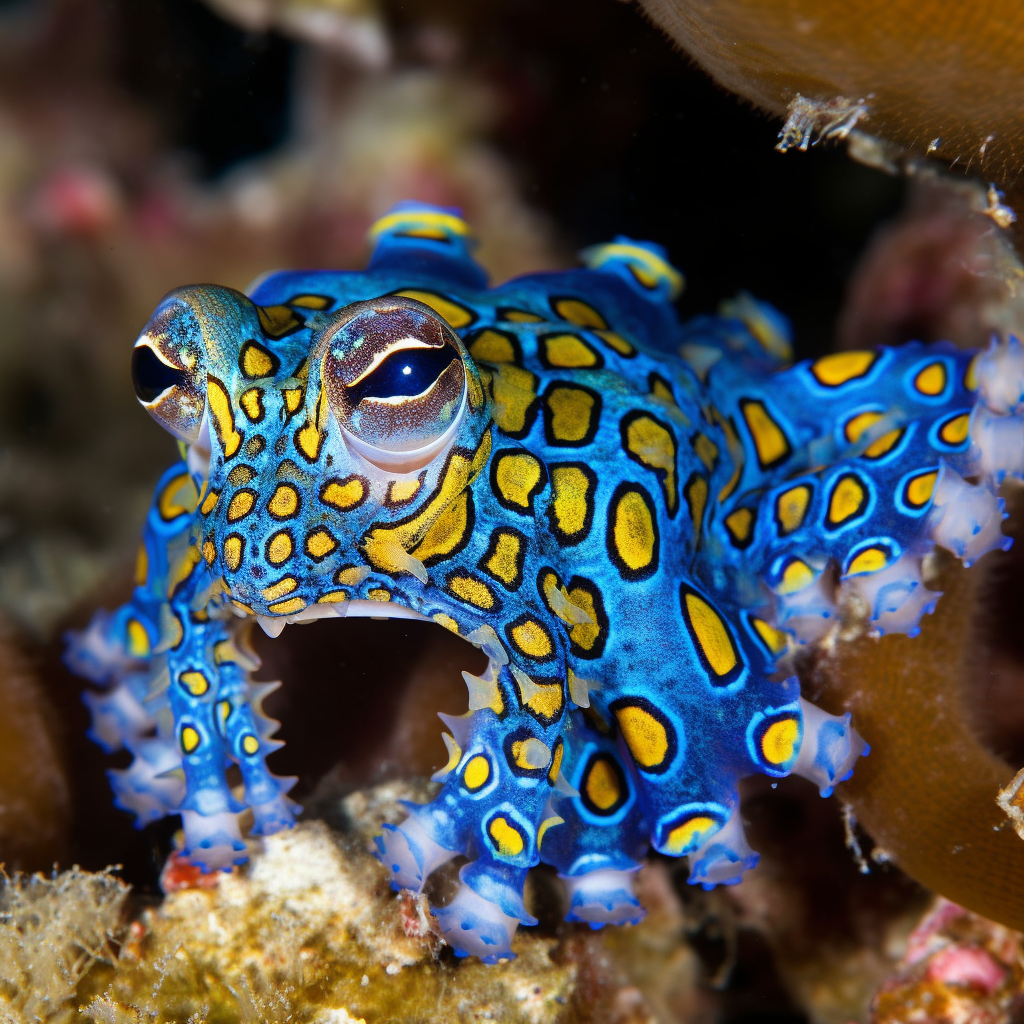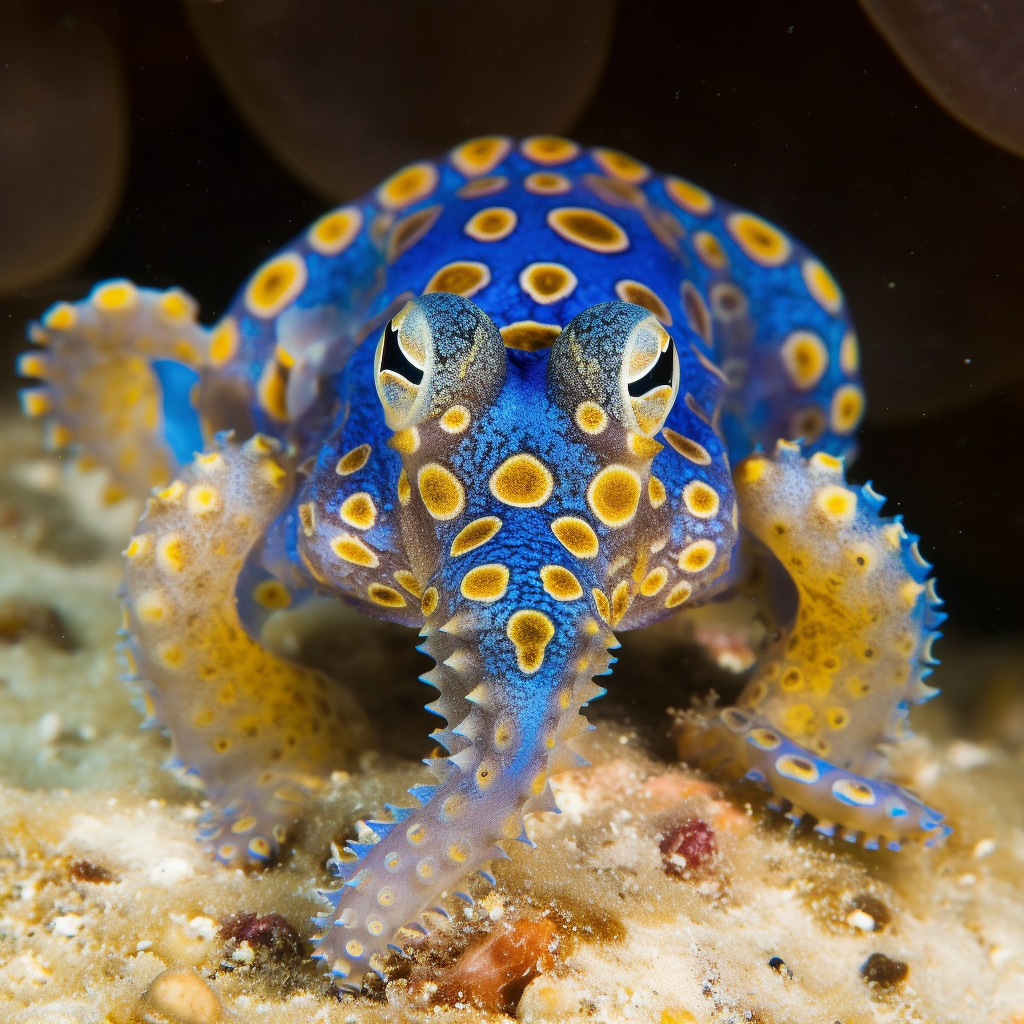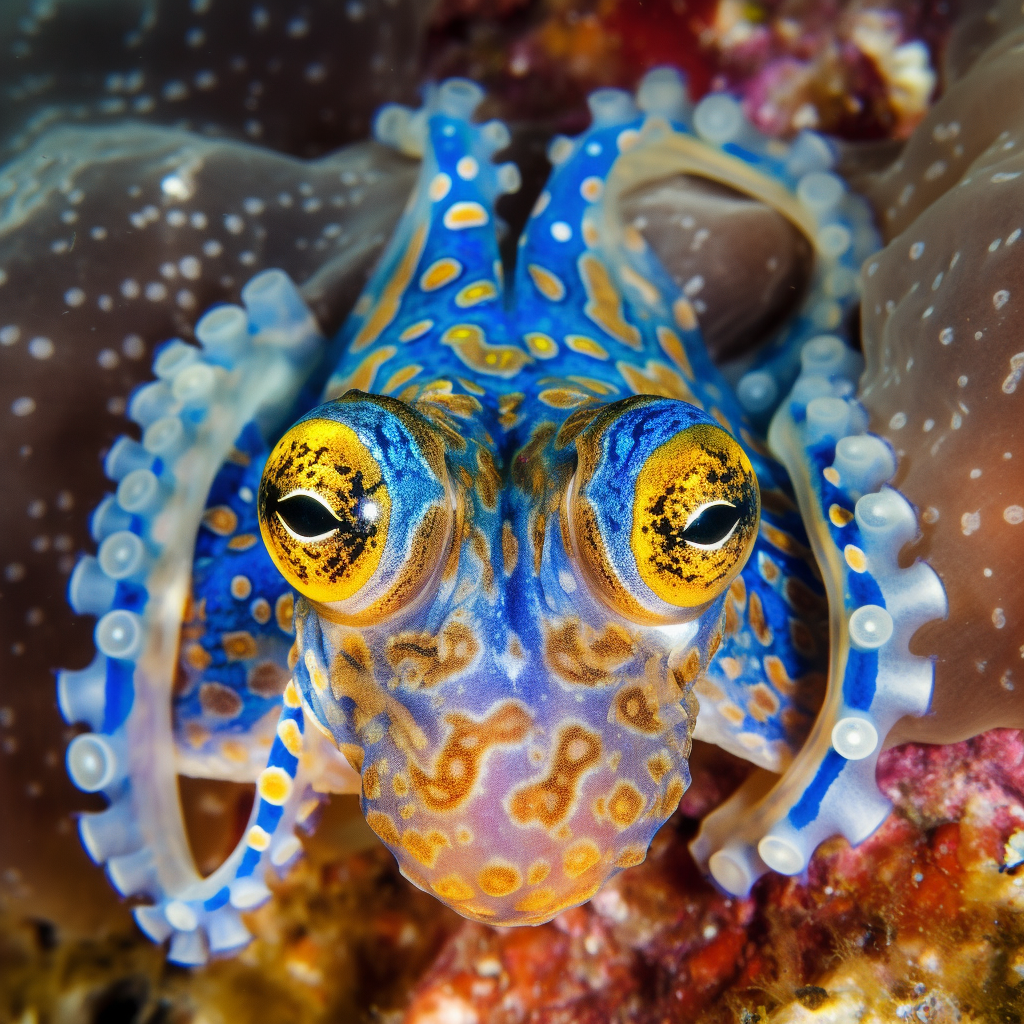The blue-ringed octopus is a fascinating and highly venomous creature that inhabits the waters of the Pacific and Indian Oceans. Despite its small size, this octopus is known for its vibrant blue rings that serve as a warning to potential predators. These rings are a telltale sign of the deadly venom that the blue-ringed octopus possesses, making it one of the most dangerous marine animals in the world. In this article, we will delve into the characteristics, behavior, and habitat of the blue-ringed octopus, as well as explore the unique adaptations that allow it to survive in its underwater environment. So, let’s dive in and discover the captivating world of the blue-ringed octopus.
Key Takeaways
- The blue-ringed octopus is a highly venomous marine animal found in the Pacific and Indian Oceans.
- It is small in size but possesses one of the most potent venoms in the animal kingdom.
- The blue-ringed octopus displays bright blue rings as a warning sign when threatened.
- Its venom can cause paralysis and respiratory failure, potentially leading to death.
- It is important to exercise caution and avoid handling or disturbing these octopuses in their natural habitat.
Understanding the Blue-Ringed Octopus
The blue-ringed octopus is a fascinating creature that inhabits the waters of the Pacific and Indian Oceans. Known for its vibrant blue rings and small size, this octopus is both beautiful and deadly. In this section, we will explore the appearance, size, species, scientific name, habitat, lifespan, and diet of the blue-ringed octopus.
A. Appearance and Size of the Blue-Ringed Octopus
The blue-ringed octopus is a small cephalopod that measures only a few inches in length. Despite its diminutive size, it possesses a striking appearance. When it feels threatened or agitated, the blue-ringed octopus displays its vibrant blue rings, which serve as a warning to potential predators. These rings are a result of specialized cells called chromatophores, which contain pigments that can be expanded or contracted to create the distinctive pattern.
In addition to its blue rings, the blue-ringed octopus has a yellowish-brown body with various patterns and textures that help it blend into its surroundings. This camouflage is crucial for its survival, as it allows the octopus to hide from both predators and prey.
B. The Blue-Ringed Octopus Species and Scientific Name
The blue-ringed octopus belongs to the genus Hapalochlaena, which consists of three recognized species: Hapalochlaena maculosa, Hapalochlaena lunulata, and Hapalochlaena fasciata. Each species has its own unique characteristics and distribution.
Hapalochlaena maculosa, also known as the greater blue-ringed octopus, is found in the waters of Australia, including the Great Barrier Reef. Hapalochlaena lunulata, or the lesser blue-ringed octopus, is found in the waters of Japan, Indonesia, and the Philippines. Hapalochlaena fasciata, the southern blue-ringed octopus, is found in the waters of southern Australia and Tasmania.
C. The Habitat of the Blue-Ringed Octopus
The blue-ringed octopus is primarily found in shallow coastal waters, including tide pools, coral reefs, and sandy or rocky seabeds. It prefers warm tropical and subtropical waters, which provide an abundance of prey and suitable breeding conditions.
These octopuses are most commonly found in the Pacific and Indian Oceans, with a significant population residing in the waters surrounding Australia. They are well-adapted to their habitat, utilizing their camouflage abilities to blend in with their surroundings and avoid detection.
D. The Lifespan of the Blue-Ringed Octopus
The lifespan of the blue-ringed octopus varies depending on the species and environmental factors. On average, these octopuses live for about one to two years in the wild. However, in captivity, they can live slightly longer, reaching up to three years.
The short lifespan of the blue-ringed octopus is due to various factors, including predation, disease, and the energy-intensive process of reproduction. Despite their relatively short lives, these octopuses play a vital role in the marine ecosystem.
E. The Diet of the Blue-Ringed Octopus
The blue-ringed octopus is a carnivorous predator, feeding primarily on small crustaceans, such as crabs and shrimp. It uses its sharp beak to puncture the exoskeleton of its prey and inject a paralyzing venom. This venom contains a potent neurotoxin called tetrodotoxin, which immobilizes the prey within seconds.
Interestingly, the blue-ringed octopus does not chew its food. Instead, it uses its beak to tear apart its prey into smaller, more manageable pieces. This allows the octopus to consume its meal more efficiently.
In conclusion, the blue-ringed octopus is a captivating creature with its vibrant blue rings, unique appearance, and deadly venom. Its small size, specialized adaptations, and habitat make it a fascinating subject of study in the field of marine biology. Understanding the various aspects of the blue-ringed octopus, including its appearance, size, species, scientific name, habitat, lifespan, and diet, provides valuable insights into the intricate world of underwater creatures.
The Intriguing Behavior and Life Cycle of the Blue-Ringed Octopus

The Blue-Ringed Octopus is a fascinating creature that inhabits the coastal waters of the Pacific and Indian Oceans, particularly around Australia. Despite its small size, this octopus species is known for its vibrant blue rings and its potent venom. In this section, we will explore the behavior and life cycle of this intriguing marine animal.
A. The Behavior of the Blue-Ringed Octopus
The Blue-Ringed Octopus is a master of camouflage, blending seamlessly into its surroundings. It has the ability to change both the color and texture of its skin, allowing it to mimic its environment and avoid detection by predators. This remarkable adaptation is crucial for its survival in the vast ocean.
When threatened, the Blue-Ringed Octopus displays its warning colors, which are the vibrant blue rings that give it its name. These rings serve as a visual deterrent to potential predators, signaling that the octopus is highly venomous and should be avoided. It is important to note that the octopus does not display these rings unless it feels threatened, so it is best to admire it from a safe distance.
In terms of diet, the Blue-Ringed Octopus primarily feeds on small crustaceans, such as crabs and shrimp. It uses its sharp beak to puncture the exoskeleton of its prey and injects a paralyzing venom. This venom contains a powerful neurotoxin called tetrodotoxin, which can quickly immobilize its prey, making it easier for the octopus to consume.
B. The Life Cycle and Reproduction of the Blue-Ringed Octopus
The life cycle of the Blue-Ringed Octopus is truly fascinating. Like other octopus species, it goes through several stages of development. It begins as a tiny egg, which is laid by the female octopus and attached to a hard surface, such as a rock or coral.
Once the eggs hatch, the baby octopuses, known as larvae, embark on a perilous journey. They must navigate the treacherous waters, avoiding predators and finding food to sustain themselves. During this stage, they are particularly vulnerable and rely on their instinctual behaviors to survive.
As the Blue-Ringed Octopus matures, it undergoes a process called metamorphosis, where it transforms from a larva into a fully developed adult. This transformation involves significant changes in its body structure and behavior, enabling it to adapt to its environment more effectively.
When it comes to reproduction, the Blue-Ringed Octopus has a unique mating strategy. The male octopus uses a specialized arm called a hectocotylus to transfer sperm into the female’s mantle cavity. The female then stores the sperm until she is ready to fertilize her eggs. Once fertilized, she carefully tends to her eggs, ensuring they receive the necessary oxygen and protection.
In conclusion, the Blue-Ringed Octopus showcases a range of intriguing behaviors and a complex life cycle. From its remarkable ability to camouflage to its venomous defense mechanism, this small but mighty creature has captured the attention of marine biologists and underwater enthusiasts alike. Understanding its behavior and life cycle provides valuable insights into the intricate world of Australian marine life and the wonders of the ocean.
The Deadly Nature of the Blue-Ringed Octopus
The Blue-Ringed Octopus is a fascinating creature that inhabits the waters of the Pacific and Indian Oceans. While it may appear small and harmless, this octopus is actually one of the most venomous marine animals in the world. In fact, it is considered to be one of the deadliest creatures in the ocean. Let’s explore the venom of the Blue-Ringed Octopus, how it stings and kills, the appearance of a Blue-Ringed Octopus bite, and what happens when it bites you.
A. The Venom of the Blue-Ringed Octopus
The venom of the Blue-Ringed Octopus contains a powerful neurotoxin called tetrodotoxin. This toxin is produced by bacteria that live within the octopus’s salivary glands. Tetrodotoxin is a potent paralytic, which means it affects the nervous system and can cause muscle paralysis. It is the same toxin found in pufferfish and some other poisonous marine creatures.
B. How a Blue-Ringed Octopus Stings and Kills
When a Blue-Ringed Octopus feels threatened or provoked, it will display its vibrant blue rings as a warning sign. These rings serve as a visual deterrent, indicating that the octopus is highly venomous and should be avoided. If the warning is ignored and the octopus feels further threatened, it will deliver a bite.
The Blue-Ringed Octopus has a beak-like mouth that it uses to inject its venom into its prey or potential predators. The venom quickly spreads through the bloodstream, causing paralysis and eventually leading to respiratory failure. It is important to note that the bite itself is usually painless, which makes it even more dangerous, as victims may not realize they have been bitten until it is too late.
C. The Appearance of a Blue-Ringed Octopus Bite
Identifying a Blue-Ringed Octopus bite can be challenging, as it often leaves no visible marks or puncture wounds. Unlike other venomous creatures that leave fang or bite marks, the Blue-Ringed Octopus injects its venom through a small, almost undetectable puncture. This makes it difficult to determine if a bite has occurred, especially in the midst of the initial symptoms.
D. What Happens When a Blue-Ringed Octopus Bites You
If you are unfortunate enough to be bitten by a Blue-Ringed Octopus, the venom will quickly take effect. The initial symptoms may include numbness, tingling, and muscle weakness, particularly around the bite area. As the venom spreads, it can cause paralysis, leading to difficulty breathing and potentially respiratory failure.
It is crucial to seek immediate medical attention if you suspect you have been bitten by a Blue-Ringed Octopus. The effects of the venom can be life-threatening, and prompt medical intervention is necessary to counteract its paralyzing effects. Treatment typically involves artificial respiration and the administration of antivenom, if available.
In conclusion, while the Blue-Ringed Octopus may be small and beautiful, it is a highly dangerous creature. Its venom contains a potent neurotoxin that can cause paralysis and respiratory failure. If you encounter a Blue-Ringed Octopus in the wild, it is essential to admire it from a safe distance and avoid any interaction. Remember, it is always better to appreciate these fascinating underwater creatures from afar, rather than risking a potentially deadly encounter.
The Blue-Ringed Octopus in the Ecosystem
The blue-ringed octopus is a fascinating creature that plays an important role in the marine ecosystem. Let’s explore how this small but mighty octopus fits into the intricate web of life underwater.
A. Predators of the Blue-Ringed Octopus
Despite its venomous nature, the blue-ringed octopus is not without its own set of predators. While it may seem invincible, there are several creatures that pose a threat to this tiny cephalopod.
-
Moray Eels: These long, snake-like creatures are known to prey on the blue-ringed octopus. With their powerful jaws and excellent sense of smell, moray eels can easily detect and capture their prey, including the elusive octopus.
-
Triggerfish: Triggerfish are another natural predator of the blue-ringed octopus. These fish have strong jaws and sharp teeth, which they use to crush and consume their prey. They are known to be quite persistent in their pursuit of octopuses.
-
Sea snakes: Sea snakes are highly venomous reptiles that inhabit the same waters as the blue-ringed octopus. They are skilled hunters and can easily overpower an octopus, making them a formidable predator.
B. The Blue-Ringed Octopus in the Food Chain
The blue-ringed octopus occupies an important position in the marine food chain. As a predator itself, it feeds on a variety of small marine animals, including crabs, shrimp, and small fish. However, it also serves as a food source for larger predators.
-
Tuna and other large fish: Blue-ringed octopuses are a tasty treat for larger fish species like tuna. These fast-swimming predators have a keen sense of smell and can detect the scent of an octopus from a distance. Once they locate their prey, they swiftly devour it.
-
Sharks: Sharks are apex predators in the ocean, and they are not averse to including blue-ringed octopuses in their diet. While octopuses can use their incredible camouflage skills to hide from sharks, they are not always successful in evading these powerful hunters.
-
Seabirds: Some seabirds, such as gulls and cormorants, have been observed feeding on blue-ringed octopuses. These birds have sharp beaks that they use to pierce and consume their prey. They are skilled hunters and can snatch an octopus right out of the water.
The blue-ringed octopus, with its venomous bite and stunning appearance, is an integral part of the marine ecosystem. It serves as both predator and prey, contributing to the delicate balance of life underwater. Understanding its role in the ecosystem helps us appreciate the complexity and beauty of marine life.
The Endangered Status of the Blue-Ringed Octopus

The blue-ringed octopus is a fascinating creature that has captured the attention of marine biologists and underwater enthusiasts alike. However, despite its allure, the blue-ringed octopus is facing a concerning reality – it is an endangered species. In this section, we will explore why the blue-ringed octopus is endangered, the rarity of this species, and where they can be found.
A. Why the Blue-Ringed Octopus is Endangered
The blue-ringed octopus is endangered primarily due to habitat destruction and overfishing. These factors have significantly impacted the population of this species, pushing it towards the brink of extinction. As human activities continue to encroach upon their natural habitats, the blue-ringed octopus is losing its homes and food sources.
Furthermore, the blue-ringed octopus has a slow reproductive rate, which makes it particularly vulnerable to population decline. Female blue-ringed octopuses lay a small number of eggs, and they invest a great deal of energy in caring for them. This limited reproductive capacity means that even a small decline in population can have a significant impact on the species as a whole.
B. The Rarity of the Blue-Ringed Octopus
The blue-ringed octopus is considered rare because it is not commonly encountered in the wild. This species is found in the waters of the Pacific and Indian Oceans, particularly along the coasts of Australia and Indonesia. However, even within these regions, sightings of the blue-ringed octopus are infrequent.
One reason for their rarity is their small size. Blue-ringed octopuses are typically only a few inches long, making them difficult to spot in their natural habitat. Additionally, their unique ability to change color and blend into their surroundings adds to their elusiveness. These factors combined make the blue-ringed octopus a true gem of the underwater world.
C. Blue-Ringed Octopus Distribution and Where They Can Be Found
The blue-ringed octopus is primarily found in the warm coastal waters of the Pacific and Indian Oceans. They are commonly spotted along the shores of Australia, particularly in the Great Barrier Reef and the waters surrounding Sydney. These areas provide the ideal conditions for the blue-ringed octopus to thrive.
In addition to Australia, the blue-ringed octopus can also be found in other parts of the Indo-Pacific region, including Indonesia, Japan, and the Philippines. They prefer shallow, sandy or rocky habitats, where they can hide and hunt for their prey. These areas offer an abundance of small crustaceans and mollusks, which form the mainstay of the blue-ringed octopus’s diet.
It is important to note that while the blue-ringed octopus may be found in these regions, encounters with this species are still relatively rare. Their small size, excellent camouflage abilities, and elusive nature make them a challenge to spot, even for experienced divers and marine biologists.
In conclusion, the blue-ringed octopus is an endangered species due to habitat destruction, overfishing, and its slow reproductive rate. Despite its rarity, this fascinating creature can be found in the warm coastal waters of the Pacific and Indian Oceans, particularly in Australia and Indonesia. Protecting their habitats and raising awareness about the importance of preserving these unique creatures is crucial to ensuring the survival of the blue-ringed octopus for future generations to appreciate and admire.
The Fascinating Aspects of the Blue-Ringed Octopus

The Blue-Ringed Octopus is a captivating creature that inhabits the coastal waters of the Pacific and Indian Oceans. Despite its small size, this octopus species possesses several remarkable characteristics that make it a truly fascinating creature to study. In this section, we will explore three intriguing aspects of the Blue-Ringed Octopus: its neon blue rings, its incredible speed, and its diminutive size.
A. The Neon Blue-Ringed Octopus and Its Worth
One of the most striking features of the Blue-Ringed Octopus is its vibrant neon blue rings. These rings serve as a warning to potential predators, signaling the presence of a highly toxic venom. While the octopus may appear harmless and beautiful, it is actually one of the most venomous marine animals in the world. Its venom contains a powerful neurotoxin called tetrodotoxin, which can cause paralysis and even death in its prey or predators.
Despite its deadly venom, the Blue-Ringed Octopus is a valuable creature in the realm of marine biology. Scientists study this species to better understand the intricacies of its venom and its potential medical applications. The neurotoxic properties of the Blue-Ringed Octopus venom have shown promise in the development of painkillers and treatments for neurological disorders. By unraveling the secrets of this tiny octopus, researchers hope to unlock new possibilities in the field of medicine.
B. The Speed of the Blue-Ringed Octopus
While the Blue-Ringed Octopus may not be the largest creature in the ocean, it certainly makes up for its size with its incredible speed. This octopus is known for its agility and swift movements, allowing it to navigate its surroundings with ease. Its ability to dart and swim quickly enables it to catch prey and evade potential threats.
The Blue-Ringed Octopus possesses a unique hunting strategy. It uses its speed and agility to ambush unsuspecting prey, such as small fish and crustaceans. With lightning-fast movements, it pounces on its target, immobilizing it with its venomous bite. This combination of speed and venom makes the Blue-Ringed Octopus a formidable predator in its underwater habitat.
C. The Small Size of the Blue-Ringed Octopus
Despite its impressive capabilities, the Blue-Ringed Octopus is relatively small in size. On average, it measures only about 5 to 8 inches in length, making it one of the smallest octopus species. Its diminutive size allows it to hide and camouflage itself among the coral reefs and rocky crevices where it resides.
The small size of the Blue-Ringed Octopus also presents challenges when it comes to reproduction. Female octopuses lay a small number of eggs, which they carefully guard and protect until they hatch. The survival of the offspring is crucial, as they face numerous threats from predators in their early stages of life.
In conclusion, the Blue-Ringed Octopus is a captivating creature with several fascinating aspects. Its neon blue rings serve as a warning of its potent venom, making it a valuable subject of study in the field of marine biology. Despite its small size, it possesses remarkable speed and agility, allowing it to thrive in its underwater habitat. By understanding the intricacies of this unique octopus, we gain insights into the wonders of the natural world. Conclusion
In conclusion, the blue-ringed octopus is a fascinating and highly venomous creature found in the waters of the Pacific and Indian Oceans. Despite its small size, it possesses one of the most potent toxins in the animal kingdom, making it a formidable predator. The distinctive blue rings that give this octopus its name serve as a warning to potential predators and humans alike. While encounters with this creature can be dangerous, it is important to appreciate its role in the marine ecosystem and to exercise caution when exploring the ocean. By understanding and respecting the blue-ringed octopus, we can ensure the safety of both ourselves and these remarkable creatures.
Frequently Asked Questions
1. Why are blue ringed octopuses endangered?
Blue ringed octopuses are endangered due to a combination of factors including habitat loss, pollution, and climate change. Their specific habitat needs make them particularly vulnerable to changes in their environment.
2. How fast is a blue ringed octopus?
A blue ringed octopus can move quite quickly when it needs to, but typically they are slow movers. They prefer to use their excellent camouflage skills to avoid predators rather than trying to out-swim them.
3. What is a blue ringed octopus worth in Adopt Me?
In the game Adopt Me, the value of a blue ringed octopus can vary based on its rarity and the demand among players. It’s best to check the latest trading values in the game.
4. How deadly is a blue ringed octopus?
The blue ringed octopus is one of the most venomous marine animals in the world. Its venom contains a neurotoxin called tetrodotoxin, which can cause paralysis and death in humans if not treated immediately.
5. Where do blue ringed octopuses live?
Blue ringed octopuses are found in the Pacific and Indian Oceans, from Japan to Australia. They prefer shallow reefs and tide pools.
6. What does a blue ringed octopus eat?
Blue ringed octopuses feed on small crustaceans, including crabs and shrimp, as well as small injured fish.
7. How venomous is a blue ringed octopus?
The blue ringed octopus is extremely venomous. Its venom is about 1,000 times more powerful than cyanide, and one octopus carries enough venom to kill 26 adults within minutes.
8. How big is a blue ringed octopus?
Blue ringed octopuses are quite small, with an average size of 5 to 8 inches (12 to 20 cm) including their arms.
9. What does a blue-ringed octopus bite look like?
A bite from a blue-ringed octopus may leave a small, painless mark. However, the venom can cause a variety of symptoms including numbness, nausea, vision loss, and in severe cases, respiratory failure.
10. How does a blue ringed octopus kill you?
A blue ringed octopus kills by injecting a potent neurotoxin through its beak. This venom blocks nerve signals throughout the body, leading to muscle paralysis, including the muscles needed for breathing. Without immediate medical treatment, death can occur within minutes.




